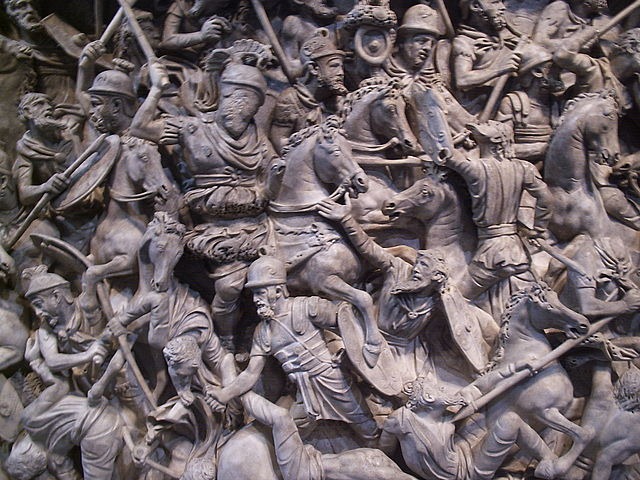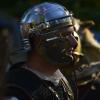Клуб за исторически възстановки от Добрич ще участва във фестивал в Рим
Добрич. Чест за нашия малък исторически клуб е да бъдем поканени за участие в такова грандиозно събитие като празника на Рим (Natale di ROMA), когато се чества основаването на „Вечния град” през Античността, заяви председателят на клуб “Сдружение за исторически реконструкции – Скития Минор – IV легион Скитика” Радостин Колчев, предаде кореспондентът на Радио „Фокус” – Варна. В този фестивал са поканени за участие клубове от цял свят, които имат подготовка за дадения исторически период (Републикански римски период и Късноантичен). Фестивалът няма толкова дълга история, разказа Радостин Колчев, провежда се от около 5 години, но набира все по-голяма популярност. По неговите думи, тази година във фестивала ще се включат клубове от почти всички европейски страни с антична римска история. „Ние дълго се подготвяхме за този фестивал и съм сигурен, че ще се представим на много високо ниво”, каза Радостин Колчев и допълни, че на добричкия клуб вече е засвидетелствано уважение от страна на Община Рим и Gruppo Storico Romano - организаторите на Natale di ROMA в Рим, заради педантичността в изработването на униформите. Всеки клуб си избира определена историческа тема или период, на който да акцентира при представянето. Клуб „Скития Минор” е предпочел периода I век пр. Хр.- I / II век сл. Хр. Ползва се оборудване, характерно за времето 50-та година преди новата ера и 202 и 250 година след новата ера. Ще бъдат представени предимно милитаристичната част – самия легион с оръжието, и цивилната част – мъже и жени в римско облекло, примерно първите в сенаторски одежди, а дамите като матрони. Клубът има напълно оборудвани центурион, аквилифер (орлоносец), сигнифер (знаконосец), имагинифер (носещ портрета на императора), корницен (тръбач), и шестима легионери. Това не е първо участие на добричкия клуб в празника на Рим. Става дума за една различна обстановка, в която човек може да се пренесе в атмосферата на Античността, „усещането е неповторимо и няма с какво да бъде сравнено”, разказа Радостин Колчев. Като човек, който изучава историята заради своя интерес и любов към нея, той посочи, че в нашата страна има много антични центрове, но за съжаление те са пренебрегнати и не достатъчно добре експлоатирани като културни ценности. „Ние бихме могли като държава с такова богато културно наследство да направим не по-лоши фестивали от този в Рим, да не забравяме, че античните Одесос, Сердика, Бритос, Дорусторум не са отстъпвали по красота на Рим”, каза Радостин Колчев. По думите му, за да стане човек член на историческия клуб, единственото условие е да има познания и желание за обогатяване на знанията за античната история на нашата държава. Някои от членовете на клуба имат предпочитания към тракийското ни минало, други – към римското време, трети са привърженици на българската по-нова история – Възраждането, Първата и Втора световна война. Според Радостин Колчев Античността е една много интересна и ползотворна тема, която все още не е достатъчно добре експлоатирана в страната, и много български общини са длъжници на това културно наследство, което заслужава внимание и от гледна точка на проучвания, и от гледна точка на опазване на богатството, дошло от Античността. „Античната история на ниво Балкани може единствено да ни обединява”, коментира Радостин Колчев, „защото тя не е пропита с негативната енергия на по новата история на Балканския регион”. В античните времена на Балканите са живеели различни племена като елини, тракийци, но те са имали сходни езици, сходна култура, коментира Радостин Колчев. Според него на тази основа е възможно само да бъдат поставени мостове на приятелство между всички балкански държави. Клубът за исторически възстановки “Сдружение за исторически реконструкции – Скития Минор –IV легион Скитика” е създаден през септември 2010 година в Добрич. В клуба членуват историци, хора, изучавали латински език, други, които са почитатели на историческите филми, колекционери. Възрастовата граница е в широк диапазон, но все пак става дума за зрели хора – над 28 години, подчерта Радостин Колчев, защото според него “все пак да се занимава човек с история и да навлиза по-дълбоко в тази материя, трябва да има зрялост”. До този момент клубът има две успешни участия на фестивали в Италия, също и в Румъния. Първото участие е реализирано съвместно с един холандско-белгийски клуб (преди 3 години) и другото миналата година, вече самостоятелно. Желанието на членовете на “Скития Минор –IV легион Скитика” е да показват в страната и по света, че в Добрич има един отличен клуб за исторически реконструкции, заяви председателят му Радостин Колчев. Името на клуба е свързано с факта, че историческият Legio IIII Scythica е станувал през 1 в. от н. е. на територията на днешна Добруджа. http://focus-news.net/?id=n1762028



